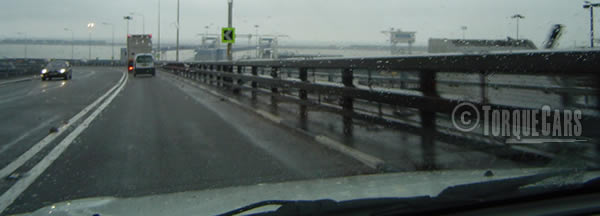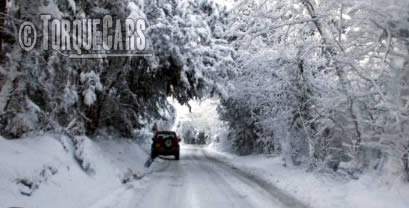Driving in adverse winter weather conditions
"Weathering heights!"

Winter driving in Rain and flooded areas.
The biggest danger from rain is a condition know as aquaplaning, caused by drivers going too fast for the road conditions.
Aquaplaning happens when people drive too fast in wet conditions.
The tyre is unable to expel the water and a film of water builds up under the tyre causing the car to "float" over the road surface. When this happens the steering will feel light and you will have no control over the car.
Braking, steering and accelerating should all be avoided as these can adversely affect the car and provoke a skid. Ease off the accelerator and when the car has slowed to a level that the tyres can cope with, grip will have been restored to you.
On fast roads this can be a significant hazard and is one that most experienced drivers have encountered at least once.
Prevention is better than cure, select good quality tyres with plenty of tread. Winter tyres are a great idea.
More tread equals a bigger amount of water which can be expelled by the tyre. Secondly you should drive at a slower speed and keep well within the danger point especially in winter weather driving conditions.
Heavy rain may wet the road enough for you to maintain grip but when you hit a large pool of water the balance could easily be lost and the car start aquaplaning as some of our members found to their cost in the TorqueCars forum.
Also be alert to the light steering feel as this is the only warning you will get, and exercise extra caution when descending a hill. Visibility is reduced so set your wipers to a speed with which they can cope with expelling the rain.

Flooded roads also present a unique danger. Driving too quickly through a flood will cause water to splash up into the engine components and cause the car to stall.
Rule 1 is keep your speed down, use the centre of the road as the camber usually is highest at this point and check the depth of water before you drive into it (are pedestrians wading through, are there markers like a wall which could indicate the depth, have other cars driven through it?)
Rule 2 is keep your revs up - use the clutch if you want to slow up.
The minute you lift off the accelerator you run the risk of sucking water in to the engine and engines are not happy when they fill up with water! Damage to a water filled engine can often require a complete engine rebuild, the sudden cooling of the pistons, loss of lubrication, steam build up pressure the list goes on.
Driving tips in Snow

Driving in snow is also fraught with hazards.
ICE and compacted snow is often concealed below the fresh snow and can make the road treacherous, if you do not have to make a journey in snow and ICE stay at home.
Keep the car moving at all times, when the car stops you will have problems gaining traction and getting the car moving again. Pulling off on snow and ice will require a lot of concentration, as you accelerate the car will veer to one side.
It is imperative that you keep your speed down, once a skid starts it is very hard to stop it and you are at the mercy of the laws of physics!
Pull away in second gear riding the clutch, if the wheels spin DO NOT KEEP ACCELERATING, just ease off a little. Moving the car backwards and forwards a little in a rocking motion may help you to get out if you find you are stuck but this can be quite heavy on the clutch and gearbox.
Sometimes steering left and right will allow the front wheels to get a little more grip. Fresh snow gives more grip than packed snow so try to keep the front wheels in areas other cars have missed but be conscious of the possibility of kerbs and potholes.
Fitting snow chains to the driven wheels will help you gain some traction we would also recommend snow socks and winter tyres.
If you should find that you are stranded in the car do not leave the engine running without checking that the exhaust pipe is clear, a build up of snow could cause the poisonous exhaust fumes to enter the car.
Run the engine each hour or so to keep some warmth coming into the car and get out periodically to ensure that you are not buried inside the car.
Keeping the wipers running will help to keep you aware of the unfolding situation. If you expect that you might encounter heavy snowfall TorqueCars recommend that you prepare first by taking along a blanket and flask of hot coffee or tea but obviously avoid alcoholic beverages.

Winter driving tips for Fog.
Only use your fog lights when visibility is really low as so many people drive around with them on blinding other motorists unnecessarily.
Only drive as fast as your stopping distance permits. This is common sense but it is shockingly ignored by so many motorists.
Just think about it for a minute. If you cannot stop safely in the distance you can see ahead you are asking for trouble.
Don't ever assume that the car in front will protect you or give you warning - that is how pile ups occur with the car in front stopping instantly as it hits the traffic in front leaving you to pile into the back of him often before you have even had a chance to reach the brake pedal.
Turn on your lights and use a dipped beam or you will just get a glare back from the fog.
General winter driving tips:
4 wheel drive gives excellent traction in wet and icy conditions when compared with a 2 wheel drive car but you are still subject to the same laws of physics when it comes to stopping and steering so bear this in mind before you start to use the advantageous traction when pulling away.
When steering on a slippery or low grip surface you must ensure that you are gentle and progressive as sudden jerky movements can cause you to lose grip and skid off the road.
Windy conditions can be a problem, look out particularly when passing high sided vehicle. They could easily be blown into your path.
Beware of leaves as these can often be as slippery as ice and accumulate on corners. Even the best tyres in the world will not help you to grip on leaves so slow up and make sure you keep control of the car at all times.
Please Check out my YouTube channel, we're regularly adding new content...
PLEASE HELP: I NEED YOUR DONATIONS TO COVER THE COSTS OF RUNNING THIS SITE AND KEEP IT RUNNING. I do not charge you to access this website and it saves most TorqueCars readers $100's each year - but we are NON PROFIT and not even covering our costs. To keep us running PLEASE Donate here
If you liked this page please share it with your friends, drop a link to it in your favourite forum or use the bookmarking options to save it to your social media profile.
Feedback - What do You Think?
Please use our forums if you wish to ask a tuning question, and please note we do not sell parts or services, we are just an online magazine.
Help us improve, leave a suggestion or tip
Please watch this video and subscribe to my YouTube channel.
One Response to “Winter driving tips for rain, flood, snow and foggy road conditions.”

 Click to accept YouTube Cookies & Play.
Click to accept YouTube Cookies & Play.
I do not recommend using the clutch when wading thru deep water as if you disengage it that will allow water to enter and get between it and the flywheel and it will cause the clutch to slip.Always drive thru deep water at a slow steady speed and when out of it continue to drive for some distance with the braked lightly applied to ensure they work properly.This is extremely important especially if the vehicle has drum brakes and slightly less so with disc brakes.